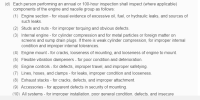(IO-360-C1C, 2000 TBO) My engine is running towards 1400 SMOH (/500 STOH). I started to wonder if one is required to an overhaul or not for the legality.
My insurance states that the airplane needs to be an in airworthy condition.
I checked the FAA documentation and that is rather vague as to what is airworthy.
Looking at this https://www.faa.gov/documentlibrary/media/notice/n_8900.410.pdf to find out what precisely is necessary it seems confusing to me.
For part 135 it seems to be more defined, it is necessary. But for part 91, it seems to be ambivalent as to what one is required to do.
I know that a TOH doesn't reset a MOH for that matter, but then again the documentation seems to separate maintenance from inspection and then is again rather vague
about manufacturer recommendation vs required inspections.
Looking at this wording:
~~
Mandatory or Not. While the concept of part 91 operators not having to comply withmanufacturer’s TBO limits is well known, the reasons behind it have not been very well documented, although, Advisory Circular (AC) 20-105, Reciprocating Engine Power-Loss Accident Prevention and Trend Monitoring, has provided guidance since 1998. The regulations require that part 91 operators have an “inspection program” of some sort. The program could be a 100-hour, annual, manufacturer’s recommended inspection program, or one of the operator’s own design, depending on aircraft type.
~~
So what is it? What I am looking for is continued airworthiness and reducing grey area.
Any guidance or experience you could share?
xander
My insurance states that the airplane needs to be an in airworthy condition.
I checked the FAA documentation and that is rather vague as to what is airworthy.
Looking at this https://www.faa.gov/documentlibrary/media/notice/n_8900.410.pdf to find out what precisely is necessary it seems confusing to me.
For part 135 it seems to be more defined, it is necessary. But for part 91, it seems to be ambivalent as to what one is required to do.
I know that a TOH doesn't reset a MOH for that matter, but then again the documentation seems to separate maintenance from inspection and then is again rather vague
about manufacturer recommendation vs required inspections.
Looking at this wording:
~~
Mandatory or Not. While the concept of part 91 operators not having to comply withmanufacturer’s TBO limits is well known, the reasons behind it have not been very well documented, although, Advisory Circular (AC) 20-105, Reciprocating Engine Power-Loss Accident Prevention and Trend Monitoring, has provided guidance since 1998. The regulations require that part 91 operators have an “inspection program” of some sort. The program could be a 100-hour, annual, manufacturer’s recommended inspection program, or one of the operator’s own design, depending on aircraft type.
~~
So what is it? What I am looking for is continued airworthiness and reducing grey area.
Any guidance or experience you could share?
xander

